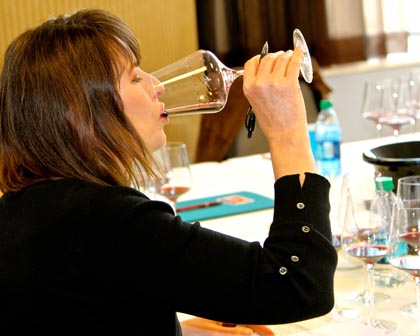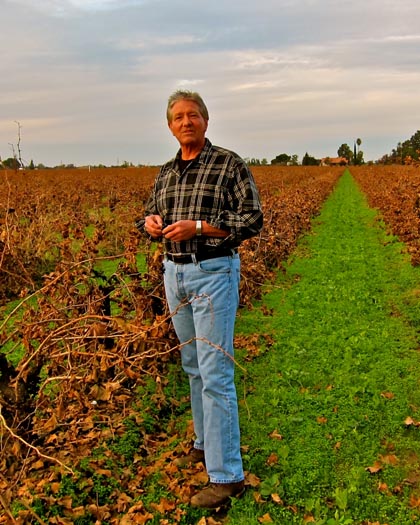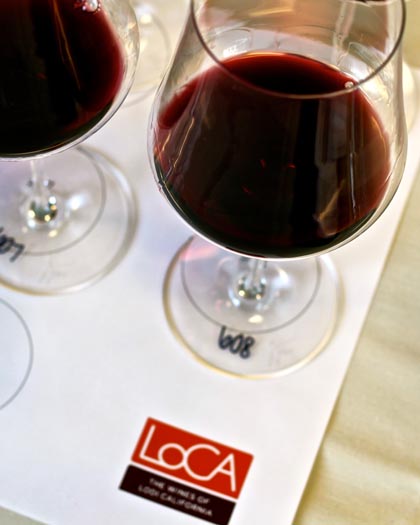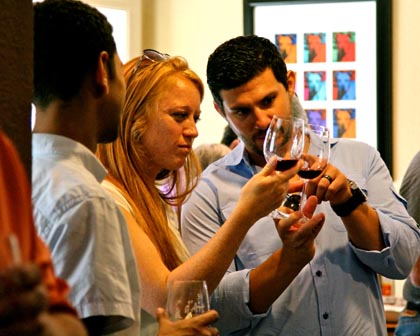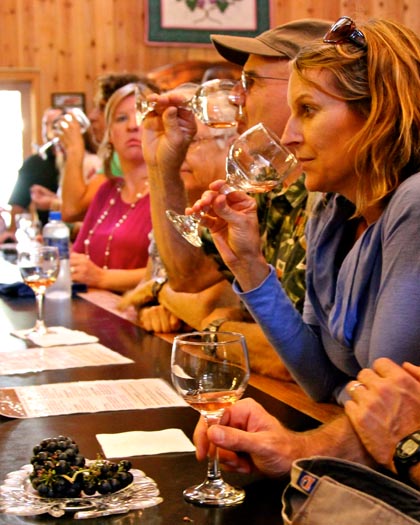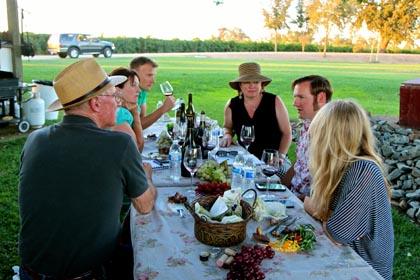Letters from Lodi
An insightful and objective look at viticulture and winemaking from the Lodi
Appellation and the growers and vintners behind these crafts. Told from the
perspective of multi-award winning wine journalist, Randy Caparoso.
How to be your own judge of good wine
Wine journalist Deborah Parker Wong blind tasting Lodi Zinfandels
Burgundy, schmurgundy
I started out on Burgundy but soon hit the harder stuff. Not really. But that line from one of Bob Dylan's classic old songs (Just Like Tom Thumb’s Blues) always sounded great.
Burgundy is a place in France where they grow grapes like Pinot Noir and Chardonnay. During Dylan's early (and, many say, best) days – the sixties and seventies – Burgundy, to most Americans, was the cheap, easy drinking, generic red wine you would usually buy by the gallon or half-gallon "jug." To the eternal horror of the French, the "Burgundy" made in California rarely, if ever, contained a drop of actual Pinot Noir. Up until the eighties, in fact, Lodi grown Zinfandel and Carignan made up the base wine of many of the best selling brands of California Burgundy.
Peirano Estate’s Lance Randolph, whose family grew Zinfandel going into E. & J. Gallo’s Hearty Burgundy for many years
The old songs still sound great, but not so great were the white wines that most Americans drank during the sixties and seventies: we called it Chablis, which also sold by the jug, or box. Real Chablis, like Burgundy, is a place in France. To produce Chablis in France, it must be made from Chardonnay – considered France's finest white wine grape. Problem was, there wasn't much Chardonnay planted in California or anywhere else in the U.S. forty, fifty years ago. Therefore, most American "Chablis" used to be made from Thompson Seedless – the same grape we still use for raisins – blended in with less familiar (at least to wine lovers today) white wine grapes such as French Colombard and Chenin Blanc.
But of course, international laws eventually caught up with us – the U.S. may no longer produce wines with generic names like "Burgundy" and "Chablis." Not that the American versions ever resembled the original Burgundy and Chablis wines from France. We now drink mostly "varietal" wines, sold by the names of grape varieties, such as Chardonnay, Merlot, Cabernet Sauvignon, Zinfandel or Pinot Noir.
Yet wine still remains a mystery to many Americans. We can be afraid of it, like changing our own oil or doing our own plumbing. Life was simpler back when white wine was Chablis and red wine was Burgundy – when men were men, and women stayed home and cooked. In other words, when we didn't know better, and wines were not nearly as good as they are today. Frankly, today's kids – that is, our new young adults of legal drinking age –have no idea how good they have it.
Yet for years and years Europeans, and even our own wine press, had most of us convinced that wine quality is inextricably tied to the specific soils of vineyard sites located in (naturally) Europe. Not too long ago, it was commonly thought that great wine can’t possibly be made in places like California, let alone Washington, Oregon, New York or Texas. Now we know better: specific soil is overrated, and great wine can be produced anywhere there are decent climatic conditions, and given deep enough pockets of Americans with the audacity to think they can grow and produce as good a wine as anyone. Like in The Music Man, many American winegrowers and winemakers have employed a "think system," and guess what – it often works!
Same ol’ whine (in new bottles)
What we find amazing, after all these years, is how some of the old myths associated with wine appreciation still die hard, even among the professionals or “experts” in the business. An old one is the slavish following of published wine writers: the thinking that just because some people taste a lot of wine, churn out provocative descriptions and slap numerical scores onto wines, those people must know better than ordinary consumers about the quality of wines.
Quite often they do, but here's the inside scoop: wine writers put on their pants one leg at a time just like everyone else. In fact, we have known and tasted wine alongside countless media-affiliated people, and more than a few times have walked away with the impression that some of them couldn't tell a good (or bad!) wine if it smacked them upside the head.
That's because knowing wine – and being able to string words, hype a blog or land a spot with a publication or Web site – is not the same as having the ability to taste and judge wine with accuracy. Plus, there is that little thing called "taste." We can all have good taste, but what are the chances of someone else's taste being exactly the same as yours? Not much.
Of course, there’s something to be said for following the advice of wine writers or critics who taste a lot of wine. That something, though, can be a negative as much as positive. The fact that wine writers taste a lot of wine can be an issue in itself because, under those circumstances, even the best of them end up rating wines in terms of intensity rather than subtlety or balance. Whenever anyone is presented with a line-up of wines to be tasted blind, you cannot help but go for the wines that stand out; and the wines that stand out, usually ending up with the highest “scores,” are those that are
- Higher in alcohol, since higher alcohol wines taste fuller and often richer
- Fruitier and rounder, especially in terms of “varietal character”
- Oakier, since oak qualities enhance sense of richness
- In the case of red wines, darker color and more tannin (the latter, giving thicker, harder, slightly bitter sensations)
- Often in the case of European wines, wines that are stronger in leathery or earthy qualities
As a consumer, you are in great shape if this describes exactly the kinds of wines you like. But more is never automatically better. What if you appreciate lighter, more restrained wines, with less obvious fruitiness and crisper, sharper qualities? What if you prefer a wine that tastes of mild rather than exaggerated fruit qualities; and more of minerals, with very little or no oak aromas and tannins? What if you dislike wines that smell and taste like leather, compost or cow poop? Then unfortunately, you’re out of luck — subtlety rarely garners the highest praise and scores in most publications and Web sites.
So whenever you read a review or make note of a wine rating, keep this in mind: it is not much more than a reflection of someone’s dubious opinion or taste — which may or may not coincide with yours — and is skewed by the tasting process itself. Take reviews as suggestions or, possibly, good starting points for your own investigations into good wine; but ultimately, the only person whose taste you can truly trust is yourself.
Wine enthusiasts at Lodi’s d’Art Winery
Compromising positions at wine judgings
What else should you know? We hate to spoil it, but the results of wine judgings or tasting competitions – usually involving professionals in the wine trade coming together to dish out gold, silver, bronze and sometimes platinum medals – are nothing more than decisions usually arrived after considerable compromise by panels of people whose tastes (again) may or may not coincide with yours. How can they? The best professional wine competition judges constantly disagree with each other. Therefore, they do what people always do when called upon to make group decisions: they vote on what wines get which medals, and the majority wins out no matter how many naysayers there may have been. There is no universal standard when it comes to assessing wine quality.
This is why the results of wine judgings across the country vary so much. A winery that enters a wine in one competition might be rewarded with a "double-gold," but receive "just" a silver, bronze or no medal for the same wine in another competition. And so to hedge their bets, savvy wineries enter their wines in as many competitions as possible. Something is bound to give, because of this basic law of probability pertaining to competitions: given the exact same wines, the chances of any one group of experts choosing the same “winners” as another group is extremely low – in fact, negligible. As Oprah once said, “Everybody gets a car!”
Sommeliers can be friends
Wine lovers at Lodi’s Harmony Wynelands
For many Americans these days, the joy of wine is first discovered in nice restaurants. Especially restaurants where there are sommeliers – enthusiastic resident experts who assemble wine lists, and know enough of their wares to recommend and serve more than competently at the table. Sommeliers are great to have around because, in many cases, someone has to decipher those longer, dreary wine lists – some as heavy as old fashioned phone books. Especially since, as a rule, wines in fine restaurants cost two to four times more than what they sell for in retail stores (you have to pay, after all, for your white tablecloth, crystal wine glasses, fresh flowers, fawning waiters, beautiful hostesses, temperamental chefs, valets, dishwashers, and all the other things that make going out so much fun).
Here's another thing we know about sommeliers: they may know a lot about wines, but they still know next to nothing about the wines you like, or need. Therefore, whenever you are in a nice restaurant and feel compelled to seek a sommelier's advice: try to be as specific as possible. It might concern preferred sensations – something dry and tart, or soft and dry… something slightly sweet or very sweet… "earthy" rather than "fruity." You may be looking for the best possible wine for your dish, or for multiple dishes (like one good bottle for fish and steak). You might even need the sommelier to stick to a particular price point – the best choice of Burgundy (real Burgundy), for instance, for about $75. Whatever may be best for you, it is best to remember that sommeliers are not mind readers – they can be your best friend, but only if you clue them in on your preferences when you ask for help.
Essential extras
Thomas Jefferson once said that wine is a "necessity of life." That's because our third president was a Francophile, influenced by cultures in Europe where wine was drunk like water (and water never really tasted great in Europe). To most Americans, wine is still something of a luxury – something we can live without, but enjoy too much to go without.
Like music, books, films, or any other extras in life, we know what we like, but we often need help finding it. But also like those extras, we know from experience that price does not always equate to quality. We can easily end up paying too much for something we don't really care for; especially when we put too much faith in what we read or hear. But mostly, we end up paying too much because we don't pay enough attention to what we are drinking. We even buy wines we simply forgot we don't like; especially when we put showing off "good taste" above finding wines that taste good.
Life is just too short for that. If you like a wine that is light and smooth, you should focus on buying wines that are as light and smooth as possible. If you love red wines that are big and rough, you should remember which kinds of reds tend to be big and rough.
Apples, peaches, pumpkin pie…
At the same time, you need be honest with yourself: sometimes the wines you've been drinking, like the hairstyle or clothes you used to wear, are just plain wrong. You just didn't know "better" at the time. Most often, it's simply because our tastes evolve over time; which is why you should never be afraid to experiment with new wines within your given range of preferences. Otherwise, how would you ever know if a wine you've never tried before is even better than the wines you've been buying over and over again? If you don't try new things, you only deprive yourself.
White wine, red wine… sweet, dry, tart, soft, cherries, berries, apples, peaches, pumpkin pie – no matter what your preference, the important thing is to make the time and effort to discover what you like best. Don't doubt yourself – your taste is never wrong.
Enjoy your wines… enjoy your life!
Borra Vineyards’ Steve Borra (left) entertaining wine pros at his Gill Creek Ranch
